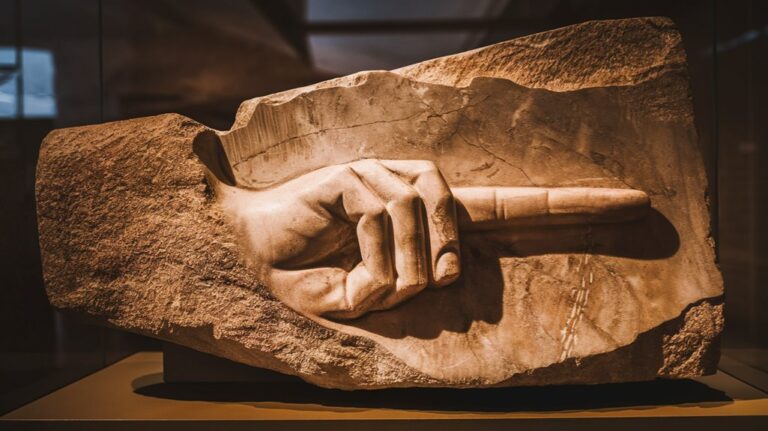The Pyramids Were Originally Covered in White Limestone
You've probably seen countless images of the Great Pyramids, with their rough, stepped exterior reaching toward the sky. But what you're looking at isn't their original appearance. These ancient wonders once wore a pristine coat of polished white limestone that made them shine like beacons across the desert. When you consider how the pyramids appear today, it's hard to imagine their initial grandeur – yet the story of their gleaming surface reveals fascinating insights about ancient Egyptian innovation and craftsmanship.
The Dazzling White Exterior

When the Great Pyramids first stood on the Giza plateau, they didn't display the sandy, stepped appearance you'd see today. Instead, you would've witnessed massive structures gleaming with polished white limestone, creating a spectacular visual impact under the Egyptian sun. The pyramid cores were constructed using rough limestone found near the building sites.
The ancient builders used fine white limestone blocks weighing up to 15 tons each, fitting them together with remarkable precision to create an almost seamless exterior. Workers transported these massive stones via Nile boats to the construction site.
You'd have been amazed by how these massive structures shone brilliantly white against the desert landscape, reflecting sunlight with dazzling intensity. This magnificent appearance wasn't just for show – it represented significant cultural symbolism, establishing the pyramids as awe-inspiring monuments worthy of Egypt's pharaohs.
While most of this limestone casing has disappeared over time, you can still spot some remnants at the pyramid of Khafre's peak.
Sourcing and Transportation of Materials
The massive scale of pyramid construction demanded an intricate network of material sourcing and transportation methods across ancient Egypt.
You'll find that each type of stone served a specific purpose, from the local low-grade limestone used in the core to the fine white limestone that created the dazzling exterior.
The ancient Egyptians developed sophisticated material sourcing and transportation methods that included:
- Mining pink granite from specialized quarries in Aswan
- Extracting fine white limestone from the Muqattam hills and Tura
- Quarrying basalt from ancient lakebeds connected to the Nile
- Producing mud bricks on-site for efficiency
You'd be amazed at how they transported these materials, using wooden sledges pulled by oxen across mud-paved paths.
For heavier materials like granite, they developed more complex transportation systems, while utilizing the Nile's waters whenever possible. At the quarries, workers would dig trenches around large granite blocks and measure their depth using cubit rods to ensure proper extraction. Recent studies have shown that the recently discovered Ahramat Nile Branch served as a crucial waterway for transporting construction materials directly to the pyramid sites.
Ancient Egyptian Engineering Expertise
Ancient Egyptian engineering expertise reached its pinnacle in pyramid construction, demonstrating levels of sophistication that would remain unmatched for millennia.
You'll find evidence of their mastery in the precise alignment of the Great Pyramid's sides with cardinal points and their advanced mathematical calculations for curves and geometric shapes.
These ancient techniques included innovative solutions like cornerstone ball-and-socket joints that allowed for thermal expansion, protecting the structure's integrity over thousands of years.
The engineering marvels they created used 2.5 million limestone blocks, each weighing about 2.5 tons, placed with remarkable accuracy.
The outside stones were crafted with incredible precision, achieving surfaces that were within 0.01 inch of perfect smoothness.
Builders used gypsum mortar to reduce friction between blocks during construction and ensure precise placement.
Whether they used ramps, internal construction methods, or early lifting mechanisms, their achievements were extraordinary.
Modern engineers continue studying these structures to understand the ingenuity behind their enduring design and construction methods.
The Art of Limestone Polishing
Modern limestone polishing techniques mirror the remarkable methods employed by Egyptian craftsmen thousands of years ago.
You'll find that today's limestone care practices combine both ancient wisdom and modern innovation, using specialized tools and methods to achieve a perfect finish.
The use of pH-neutral cleaners helps protect the stone's integrity during the initial cleaning phase.
For best results, experts recommend using mineral oil polish rather than wax-based products that can trap dirt and cause discoloration.
To maintain and restore limestone's natural beauty, professionals use several polishing techniques:
- Wet polishing with water as a lubricant for achieving high-gloss finishes
- Diamond pad polishing to remove scratches and surface imperfections
- Honing processes that create elegant matte or satin appearances
- Buffing and mechanical polishing for final touches and lasting shine
The process begins with thorough cleaning and initial grinding, followed by progressively finer polishing stages.
Whether you're working on countertops, floors, or walls, proper technique guarantees your limestone surfaces maintain their timeless appeal, just as they did on the ancient pyramids.
What Time Has Taken Away

Despite standing for over four millennia, today's beige-colored pyramids barely resemble their original gleaming white appearance. Time erosion has stripped away most of their polished Tura limestone casing, leaving behind the rougher core stones you see today.
You'll find that much of this transformation occurred during the Middle Ages when rulers repurposed the precious casing stones for other buildings.
The 6.1 million tons of limestone used in the Great Pyramid's construction demonstrates the massive scale of the original casing.
These massive monuments were constructed on the western bank of the Nile, aligning with ancient Egyptian beliefs about death and the afterlife.
 fine white limestone exterior was polished to create a dazzling reflective surface that could be seen from miles away.
fine white limestone exterior was polished to create a dazzling reflective surface that could be seen from miles away.
You can appreciate the incredible accuracy achieved through:
- Astronomical alignments that perfectly matched the four compass directions
- Advanced tools including plumb lines, copper pickaxes, and granite hammers
- Innovative construction methods like wet sand and internal ramps
- Specialized materials selection, from limestone cores to polished outer casings
Paid skilled laborers, not slaves as commonly believed, were responsible for building these magnificent structures.
Today's modern builders still marvel at these achievements.
The pyramids showcase not just engineering excellence, but also demonstrate how ancient Egyptians mastered planning, organization, and precise execution in ways that continue to influence architecture thousands of years later.










